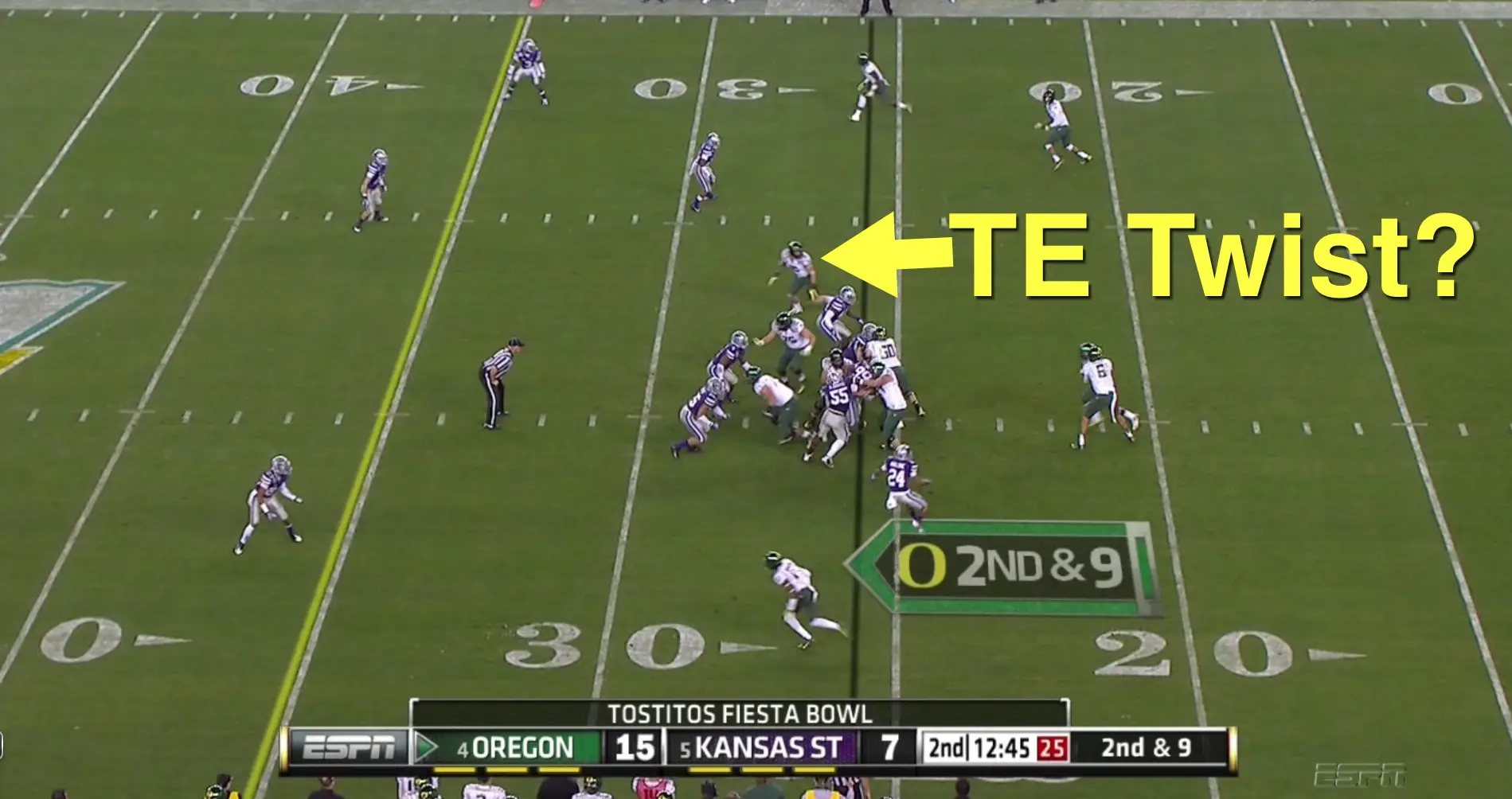We veterans of Oregon football are accustomed to the usual movements within the Inside and Outside Zone Read play and their blocking schemes. Yet in the Fiesta Bowl we ran something unusual with our tight end…. a twist within our Zone Read plays? How did it work and what were the results? Will we see it again? These are great questions for a new Oregon Zone Read strategy that the rest of the media has missed, so let’s take a look at a new wrinkle of the evolving Oregon Offense featured in the Fiesta Bowl.
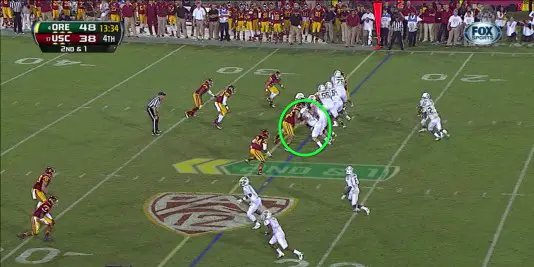
We are all quite familiar with our tight end, Colt Lyerla (above), blocking exceptionally well on the line of scrimmage (LOS) for the Inside Zone Read play against USC.
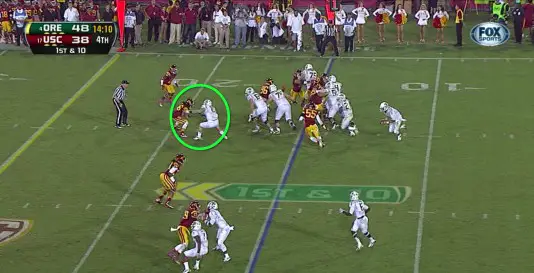
There are times when (above) I’ve noted how our TE will go inside to block the linebacker as in this example against USC last fall. It will often happen when he is bypassing the defensive end in order for the defensive lineman to be “read” by the QB, thus Colt is responsible for clearing out the LB on that side.
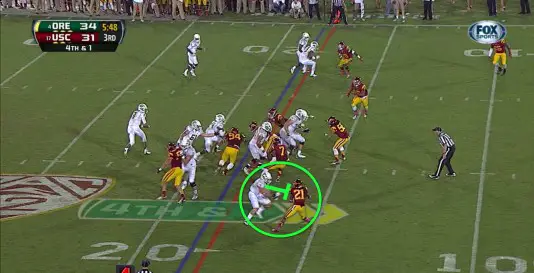
There will be an occasion for our TE to bypass the DE and the LB and go out to the next level to block a corner as we do above.
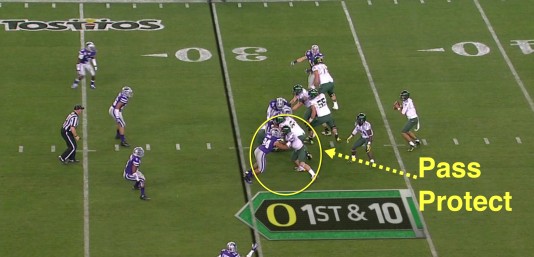
Another function of the TE that we see above is staying inside during our “Max Protect” pass blocking package to stop the pass rush from defeating our pass play.
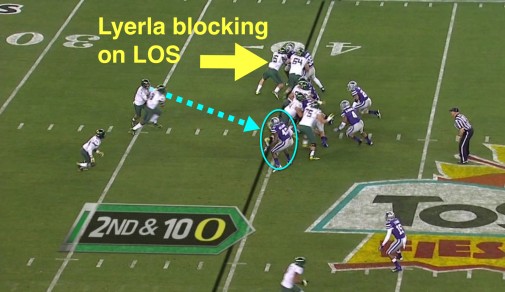
In the Fiesta Bowl we saw our TEs block at the LOS during Zone Read plays (like the one above), and help our running back get some gaps to work with. Thus far, all looks normal and usual for our Tight End in the Zone Read blocking schemes.
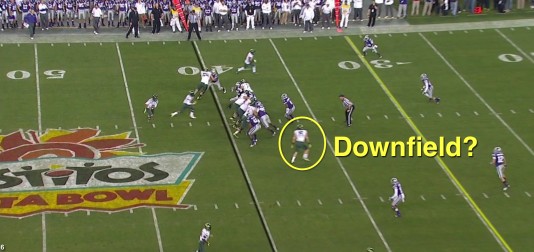
You can imagine my eyebrows going up when I watched a typical Zone Read play beginning (above); but Lyerla, our TE, is releasing downfield as if going out for a pass? Really? I was caught up in the game moments to spend very much time on this play…but it was darned peculiar.
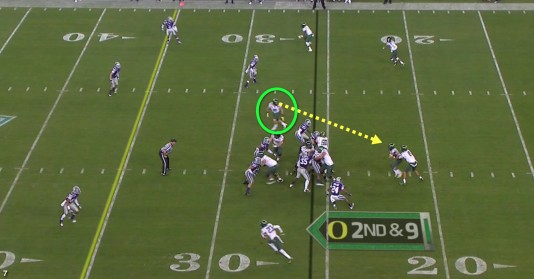
A little later we had a very clear and obvious Zone Read play again and instead of blocking a DE, LB, or DB (above), it is very evident he IS releasing downfield for a potential pass! At the time of the mesh Colt is clearly looking back for a pass and is wide open. It seems that he is trying to be a decoy and pull defenders to him…but to no avail. They aren’t biting on this ruse and will stay around the LOS to defend the run, which is the high percentage move against the Ducks.
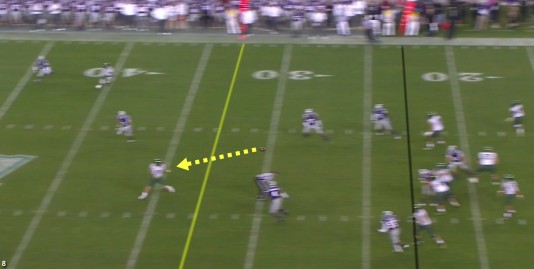
It was just before halftime with a minute left when Oregon got the ball and began to drive down the field with a play-action pass off the Zone Read play to the wide-open TE (above)! If they are going to ignore him, then we pass to him after all! It was an explosive start to the drive.
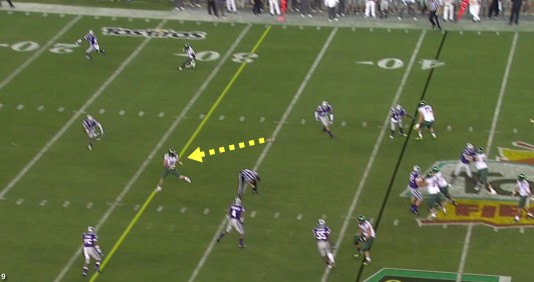
Kansas State isn’t sure what to think when the next play is a Zone Read again, but this time Lyerla stays at the LOS to block for Barner. The play after that begins as an Outside Zone Read, and our TE releases into the secondary again (above) to get open and get hit nicely by Marcus Mariota. It is another big gain on this drive. The Wildcats are unsure whether to ignore him or cover him since this is not a look we have presented before, and one that I cannot recall having seen in the past!
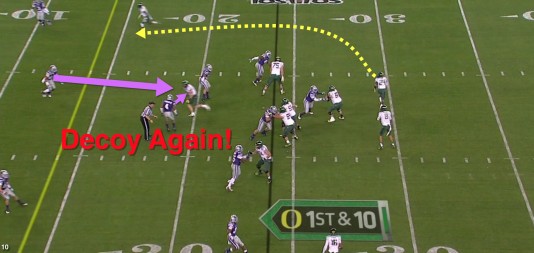
We begin the next play with a Zone Read play-action and Lyerla attracts a ton of attention as he releases downfield again (above). This time the decoy-turned-pass-receiver is well covered, but it opens up other opportunities discussed in a recent Fish Report by Josh Schlichter. Now that the safety closed in on our TE, it opened up Barner running a flare-turned wheel route for Marcus to drop the ball into for an eventual touchdown on this play!
This new “twist” of using the TE this way opened up a progression of opportunities for the Oregon offense. If the TE stayed inside to block, then the defense would want to add a man inside the box to stuff our running game. If the TE released downfield, and the defense had the extra defender in the box — then they had a decided advantage in defeating our blocks and stopping our Zone Read attack. Yet if they ignored him releasing downfield for long…it opened up tremendous opportunities for big chucks of passing yardage.
What if the defenders react by placing coverage upon him? We then hit the defense on the flanks where the safety is absent due to the coverage of our TE. It was a classic example of Oregon creating a series of weaknesses in the defense and capitalizing upon it with a new look. It is a variation, a wrinkle that I hope to see more often this next year as it utilizes our strength at Tight End!
My friends, it has been fun to turn the analysis of the week over to three others within a rotation, as I have learned so much from them and believe it benefits the site and the readers to have more than one analysis voice. I must admit though…. that it also feels good to get back in the saddle in front of the monitor and watching the plays of our men in green. It will be a tremendous off-season for learning!
“Oh how we love to learn about our Beloved Ducks!”
Charles Fischer (FishDuck)
Oregon Football Analyst for FishDuck.com
Eugene, Oregon
Top Photo from Video
Related Articles:

Charles Fischer has been an intense fan of the Ducks, a season ticket holder at Autzen Stadium for 38 years and has written reports on football boards for over 26 years. Known as “FishDuck” on those boards, he is acknowledged for providing intense detail in his scrimmage reports, and in his Xs and Os play analyses. He is single, has a daughter Christine, and resides in Eugene Oregon where he was a Financial Advisor for 36 years.
He now focuses full-time on Charitable Planned Giving Workshops for churches and non-profit organizations in addition to managing his two Oregon Football Websites, of FishDuck.com and the Our Beloved Ducks forum. He is a busy man!
He does not profess to be a coach or analyst, but simply a “hack” that enjoys sharing what he has learned and invites others to correct or add to this body of Oregon Football! See More…

